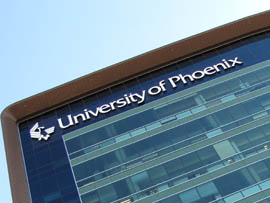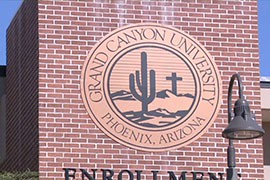Cronkite News has moved to a new home at cronkitenews.azpbs.org. Use this site to search archives from 2011 to May 2015. You can search the new site for current stories.
For-profit universities in Arizona balk at proposed federal regulations
WASHINGTON – For-profit universities in Arizona said Monday that proposed federal regulations that would make them report average student debt levels, loan default rates and other “key outcomes” are unfair and may be based on flawed data.
The U.S. Department of Education proposal, announced Friday, would set new thresholds for federal student aid eligibility of for-profits, by considering their students’ annual debt-to-earnings rate and student loan default rates over a three-year period.
In its announcement Friday, the department said the new regulations would help rein in career training programs that leave students swimming in debt while doing little to advance their careers.
But institutions that would be affected said any new rules should apply across the board – to include public universities – and that the data behind the proposal rule could be flawed.
Officials at Apollo Education Group Inc., the Phoenix-based operator of the for-profit University of Phoenix, said they were still reading through the proposed regulations and could not comment specifically on it. But they agreed with others that any transparency requirements should apply across the board.
“We maintain that for these regulations to meet the goal of providing a more transparent framework for students to make informed decisions, they should apply equally and equitably to all students at all institutions,” Apollo Chief of Staff Mark Brenner said in an emailed statement.
But Arizona’s public universities already “have a strong track record of being transparent and accountable to students, parents, policymakers and taxpayers regarding performance metrics, debt levels, earnings and more,” said one state official.
Arizona Board of Regents President Eileen Klein pointed to the “dozens of metrics” that are available to the public now through the board’s website.
“By virtue of being the governing body for the state’s three universities, the Board has a fiduciary responsibility to the public and has long monitored this information in public meetings and published it on our website in user-friendly formats,” Klein said in an emailed statement.
She said that sort of transparency “should not be too much to ask of any institution that benefits from public dollars.”
DOE headquarters in Washington were closed by a snowstorm Monday and officials there could not be reached to comment.
According to 2012 data the department released Friday, Arizona’s for-profit colleges and universities had the 10th-highest student-loan default rates of any state. Almost a quarter of those schools’ students defaulted on their student loans during the three-year reporting period.
The new regulations would penalize schools with default rates consistently over 30 percent.
The University of Phoenix had an overall default rate of 25.7 percent in 2012 – similar to three-year default rates reported by Apollo itself for 2010 and 2009. Apollo declined to comment on the 2012 default figure until it finishes its review.
The DOE said CollegeAmerica’s Flagstaff branch had the highest overall default rate in Arizona at over 40 percent. But an official with the company that operates CollegeAmerica’s Arizona branches challenged the government’s claims, saying there have been “chronic inaccuracies in the department’s data relative to default rates.”
“For the past five years, we have had to annually appeal the Department’s initial draft of cohort default rates,” said Eric Juhlin, CEO of Center for Excellence in Higher Education, in an emailed statement. “Every appeal has resulted in a reduction to the initial published rate.”
The Art Institute of Phoenix had 18 of its 52 reported programs with default rates at or above the proposed threshold in 2012, DOE said. It also had some of the highest individual default rates in the state, at 57 percent for its bachelor’s degree in culinary arts, 49.5 percent for its associate’s degree in audiovisual communications technologies and 40.6 percent for its undergraduate certificate in corrections and criminal justice.
Chris Hardman, spokesman for Education Management Corp., which operates the Art Institute of Phoenix, said the department’s numbers looked accurate, but he too opposed the proposed regulations. He said the rules disproportionately hit “the underserved communities the administration says it is trying to help.”
“At a time when our economy struggles to recover and the skills gap threatens the American workforce, the government should be increasing access to education, not restricting it,” Hardman said in an email.
The Association of Private Sector Colleges and Universities, which represents 40 higher-education institutions in Arizona, and the Arizona State Board for Private Postsecondary Education both opposed the new regulations.
Juhlin declined comment on the regulations while they are under review, but was critical of the process that brought them to this point.
“In almost every instance, the Department of Education has blatantly ignored feedback from the negotiated rule-making team,” he said in the email.








